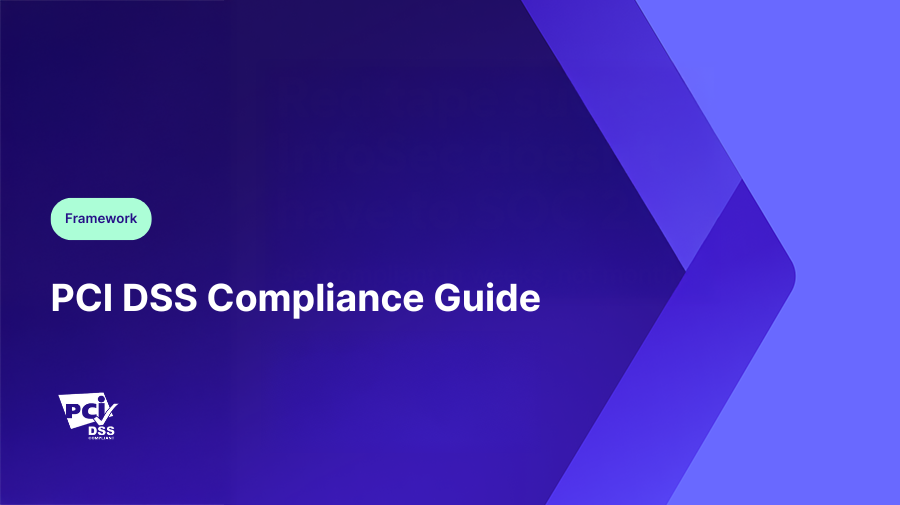Network security foundations
- Req 1: Install and maintain network security controls and firewalls.
- Req 2: Do not use vendor default passwords or settings.

Handling payment card data can be both an opportunity and a challenge. The Payment Card Industry Data Security Standard (PCI DSS) was created to help companies protect cardholder data throughout the entire transaction process.
This guide provides a clearer understanding about what PCI DSS is, why it is valuable, and how organizations can prepare for certification and minimize the burden of ongoing compliance obligations.
The PCI DSS (Payment Card Industry Data Security Standard) is a worldwide standard that was created by the PCI Security Standards Council. It describes how organizations that store, process, or transmit cardholder data must secure their systems and networks.
The PCI DSS applies to all entities that process card payments (including merchants, service providers, and financial institutions) regardless of size or number of transactions.
The PCI DSS aims to protect cardholder data by requiring implementation of consistent technical and operational security controls concerning: network security, encryption, access control and monitoring.
When there is a breach in cardholder data, organizations risk incurring significant fines, damaging their reputations, and losing the trust of their customers. However, when organizations take steps to comply with the PCI DSS, they can build and sustain a culture of security.
The following are some of the key benefits for organizations who achieve compliance:
Reduced breach risk: standardized controls minimize attack surfaces.
Customer trust: demonstrates commitment to data protection and payment integrity.
Third-party validation: provides assurance to banks, acquirers, and partners.
Regulatory alignment: complements other frameworks like SOC 2, ISO 27001, and GDPR.
Faster remediation: clear audit trails enable quicker response to incidents.
Achieving compliance is not a one-time effort. Continuous monitoring, testing, and improvement is necessary to ensure that organizations are able to maintain compliance with PCI DSS throughout the year.
Self-Assessment Questionnaires (SAQs) simplify compliance for merchants and service providers by tailoring requirements to how payment data is handled.
Choosing the right SAQ type is essential for accurate scoping and efficient audit preparation.
PCI DSS includes 12 core requirements, organized into six control objectives.
Organizations must document how each control is implemented and verify that it is operating effectively.
Define scope: identify the systems and networks that store, process or transmit cardholder data. Limit scope through segmentation and data flow investigation.
Gap assessment: identify from your current controls if they meet the PCI DSS requirements and note any gaps or deficiencies to be addressed.
Remediation: implement or enhance existing technical and administrative controls, such as encryption, access control and vulnerability management.
Internal testing: conduct penetration testing, vulnerability scanning and control validation testing for your readiness process.
Collect evidence: be sure to document evidence of the ownership of associated controls, the reviewing of monitoring logs, and the enforcement of policy. Make sure all supporting artifacts are current, relevant, and traceable.
Engage a Qualified Security Assessor (QSA): QSAs will provide the final validation and an Attestation of Compliance (AOC).
Manage continuous compliance: periodic review of configurations, periodic key and password rotation, and documentation of detectable deviations. Collecting ongoing evidence can streamline future audits.
PCI DSS compliance is more than completing a checklist during one audit; it is about continuously establishing confidence every time a transaction occurs.
With the right tools, organizations can turn PCI from an annual checkbox to a continuous control program. Complyance automates evidence collection, monitors controls in real time, and it keeps IT and compliance teams in alignment with PCI DSS 4.0 and significantly reduces manual effort and audit fatigue.
Is PCI DSS required by law? No, but it is contractually required by major card brands such as Visa, Mastercard, and American Express. Non-compliance can lead to penalties or loss of card processing privileges.
How often is PCI DSS updated? The PCI Council periodically releases new versions. Version 4.0 is the current standard, emphasizing continuous validation and risk-based testing.
How long does certification take? Depending on scope and readiness, certification can take anywhere from a few weeks to several months.
What is the difference between PCI DSS and SOC 2? PCI DSS is specific to payment data security, while SOC 2 focuses on broader system trust principles such as availability and confidentiality.
